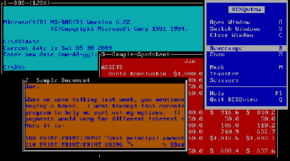DESQview

DESQview 2.8 running on top of MS-DOS 6.22 in VirtualBox
|
|
| Developer(s) | Quarterdeck Office Systems |
|---|---|
| Initial release | July 1985 |
| Last release |
DESQview/2.70
|
| Development status | Historic |
| Platform | DOS |
| License | Proprietary commercial software |
DESQview (DV) was a text mode multitasking operating environment developed by Quarterdeck Office Systems which enjoyed modest popularity in the late 1980s and early 1990s. Running on top of DOS, it allowed users to run multiple DOS programs concurrently in multiple windows.
Quarterdeck's predecessor to DESQview was a task switching product called Desq (shipped late April or May 1984) which allowed users to switch between running programs. Quarterdeck revamped its package, bringing multitasking in, and adding TopView compatibility.
DESQview was released in July 1985, four months before Microsoft introduced the first version of Windows. It was widely thought to be the first program to bring multitasking and windowing capabilities to DOS, but in fact there was a predecessor, IBM's TopView, which shipped March 1985, from which DESQview inherited the pop-up menu.
Under DESQview, well-behaved DOS programs could be run concurrently in resizable, overlapping windows (something the first version of MS Windows could not do). A simple hideable menu allowed cutting and pasting between programs. DESQview provided support for simple editable macros as well. Quarterdeck also developed a set of optional utilities for DESQview, including a notepad and dialer. Later versions allowed graphics mode programs to be loaded as well, but only run in full screen mode.
DESQview was not a GUI (Graphical User Interface) operating system. Rather, it was a non-graphical, windowed shell that ran in real mode on top of DOS, although it could run on any Intel 8086- or Intel 80286-based PC. It could also use expanded memory add-ons to work around the 640 kB RAM limit of conventional memory on early PCs. DESQview really came into its own on Intel 80386 machines, which were better at utilizing memory above DOS's limit. However, in either case, it ran in real mode rather than protected mode, meaning that a misbehaving program could still crash the system.
...
Wikipedia
